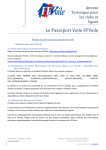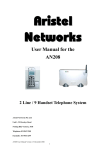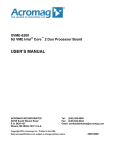Download User Manual - Adaptive Modules
Transcript
GREENTEL M2M Industrial Cellular Router User Manual For R200 M2M Industrial Cellular Router -1- ANNOUNCEMENTS ............................................................................................................................. 5 1. ROUTER INTRODUCTION ............................................................................................................. 9 1.1 FEATURES: ....................................................................................................................................... 9 1.2 APPLICATIONS: .............................................................................................................................. 10 1.3 PRODUCT KIT: ............................................................................................................................... 10 2. HARDWARE INTRODUCTION .................................................................................................... 11 2.1 R2X1HHW AND R2X1GC55 ......................................................................................................... 11 2.2 INTERFACE (FROM UP TO DOWN) .................................................................................................... 11 2.3 LED INDICATOR ............................................................................................................................ 12 2.4 R2X1UU ....................................................................................................................................... 13 2.5 R2X4HHW AND R2X4GC55 ......................................................................................................... 14 2.6 R2X4UU ....................................................................................................................................... 15 2.7 INSERT SIM/UIM .......................................................................................................................... 16 2.8. SCREW PLUGGABLE TERMINAL BLOCK ......................................................................................... 16 2.9. CONSOLE PORT PINOUT ................................................................................................................ 17 2.10 MAINTENANCE NOTES ................................................................................................................ 18 3. APPLICATION INTRODUCTION ................................................................................................. 19 4. ACCESSING THE ROUTER ......................................................................................................... 20 4.1 PC CONFIGURATION ...................................................................................................................... 20 4.2 LOGIN............................................................................................................................................ 20 4.3 SYSTEM CONFIGURATION .............................................................................................................. 21 4.3.1 SYSTEM -> BASIC SETUP ............................................................................................................ 21 4.3.2 SYSTEM -> TIME......................................................................................................................... 22 4.3.3 SYSTEM -> SERIAL PORT ............................................................................................................. 22 4.3.4 SYSTEM -> ADMIN ACCESS ......................................................................................................... 23 4.3.5 SYSTEM -> SYSTEM LOG............................................................................................................. 25 4.3.6 SYSTEM -> CONFIG MANAGEMENT ............................................................................................. 26 4.3.7 SYSTEM -> UPGRADE ................................................................................................................. 26 4.3.8 SYSTEM -> REBOOT.................................................................................................................... 28 4.3.9 SYSTEM -> LOGOUT ................................................................................................................... 29 4.4 NETWORK ..................................................................................................................................... 29 4.4.1 NETWORK -> DIALUP ................................................................................................................. 30 4.4.2 NETWORK -> LAN ..................................................................................................................... 32 4.4.3 DNS ........................................................................................................................................... 33 4.4.4 DDNS ........................................................................................................................................ 33 4.4.5 STATIC ROUTE ............................................................................................................................ 34 4.4.6 WAN (R2X4 ONLY) .................................................................................................................... 35 -2- 4.4.7 DMZ PORT (R2X4 ONLY) ........................................................................................................... 38 4.4.8 PORT MODE (R2X4 ONLY) .......................................................................................................... 38 4.5 SERVICE ........................................................................................................................................ 39 4.5.1 SERVICES -> DHCP SERVICE ...................................................................................................... 39 4.5.2 SERVICES -> DNS RELAY ........................................................................................................... 40 4.5.3 SERVICES -> VRRP .................................................................................................................... 41 4.5.4 SERVICES -> DEVICE MANAGER ................................................................................................. 41 4.5.5 SERVICES -> DTU ...................................................................................................................... 42 4.6 FIREWALL ...................................................................................................................................... 43 4.6.1 FIREWALL -> BASIC .................................................................................................................... 43 4.6.2 FIREWALL -> FILTERING ............................................................................................................. 44 4.6.3 FIREWALL -> PORT MAPPING ...................................................................................................... 45 4.6.4 FIREWALL -> VIRTUAL IP MAPPING ............................................................................................ 45 4.6.5 FIREWALL -> DMZ ..................................................................................................................... 46 4.6.6 FIREWALL -> MAC-IP BUNDLING .............................................................................................. 46 4.7 QOS .............................................................................................................................................. 47 4.8 VPN .............................................................................................................................................. 47 4.8.1 VPN -> IPSEC BASIC SETTING .................................................................................................. 48 4.8.2 VPN -> IPSEC TUNNELS ........................................................................................................... 49 4.8.3 VPN -> GRE TUNNELS .............................................................................................................. 52 4.8.4 VPN -> L2TP CLIENTS ............................................................................................................... 52 4.8.6 VPN -> L2TP SERVER ................................................................................................................ 53 4.8.7 VPN -> PPTP CLIENTS ............................................................................................................... 53 4.8.8 VPN -> PPTP SERVER ................................................................................................................ 54 4.8.9 VPN -> OPENVPN TUNNELS ..................................................................................................... 55 4.8.10 VPN -> OPENVPN ADVANCED................................................................................................. 56 4.8.10 VPN -> CERTIFICATE MANAGEMENT ....................................................................................... 56 4.9 TOOLS ........................................................................................................................................... 57 4.9.1 TOOLS -> PING .......................................................................................................................... 57 4.9.2 TOOLS -> TRACEROUTE .............................................................................................................. 57 4.9.3 TOOLS -> LINK SPEED TEST ....................................................................................................... 58 4.10 STATUS ........................................................................................................................................ 58 4.10.1 STATUS -> SYSTEM ................................................................................................................... 59 4.10.2 STATUS -> MODEM ................................................................................................................... 59 4.10.3 STATUS -> NETWORK CONNECTIONS ........................................................................................ 60 4.10.4 STATUS -> ROUTE TABLE .......................................................................................................... 60 4.10.5 STATUS -> DEVICE LIST ............................................................................................................ 60 4.10.6 STATUS -> LOG ......................................................................................................................... 61 5. HOW TO UPGRADE NEW FIRMWARE ..................................................................................... 62 6. HOW TO DIAGNOSE ..................................................................................................................... 63 7. CONFIGURE VIA TELNET ........................................................................................................... 64 -3- 8. CONFIGURE VIA SERIAL PORT ................................................................................................ 65 9. HOW TO RESET TO FACTORY DEFAULTS SETTINGS ........................................................ 69 9.1 RESET BY SOFTWARE..................................................................................................................... 69 9.2 RESET BY HARDWARE ................................................................................................................... 69 9.3 RESET BY TELNET ......................................................................................................................... 70 10. SUPPORT ...................................................................................................................................... 72 -4- Announcements Thank you for choosing our product. GREENTEL R200 series is Machine-to-machine (M2M) industrial cellular router with Din-rail mounting, which works on 2G/3G cellular networks, provides reliable and robust wireless connections. GREENTEL R200 series is specified for industrial M2M usage. Designed to endure extreme conditions, such as temperatures ranging from -25°C to +70°C and low power consumption. GREENTEL R200 series also supports the OpenVPN, PPTP, L2TP, GPE, IPSec VPN tunnel providing high-grade network security. Please read this manual carefully before using the product. Copyright Announcement Copyright GREENTEL LIMITED 2010. All rights reserved. Reproduction, transfer, distribution or storage of part or all of the contents in this document in any form without the prior written permission of GREENTEL is prohibited. Information Edition: GL – A – R200 – 2.6 -5- Important Safety Information This product is not intended for use in the following circumstances • • • • • • Area(s) where radio transmission equipment (such as cell phone) are not permitted. Hospitals, health care facilities and area(s) where cell phones are restricted by law. Gas stations, fuel storage and places where chemical are stored. Chemical plants or places with potential explosion hazard. Any metal surface that may weaken the radio signal level. The appliance is intended to be installed in restricted access location. Only service person or authorized person is allowed to access. RF safety distance For GPRS router, the compliance boundary distance is r=0.26m for GSM 900MHz and r=0.13m for DCS 1800 MHz. For HSUPA router, the compliance boundary distance is r=0.26m for GSM 900MHz and r=0.13m for DCS 1800 MHz, r=.0.094 for WCDMA 900MHz, r=0.063 for WCDMA 2100MHz. Warning This is a class A product. In a domestic environment this product may cause radio interference in which case the user may be required to take adequate measures. -6- Agency approvals and standards compliance For R211HHW-232 and R201HHW-232 Type 3.1a Health 3.1a Safety 3.1b EMC 3.2 Radio For R211GC55-232 and R201GC55-232 Type 3.1a Health 3.1a Safety 3.1b EMC 3.2 Radio Approval / Compliance EN 50385: 2002 EN 60950-1:2006+A11 EN 301 489-1 V1.8.1 EN 301 489-7 V1.3.1 EN 301 489-24 V1.4.1 EN 300 386 V1.4.1 EN 301 511 V9.0.2 EN 301 908-1 V3.2.1 EN 301 908-2 V3.2.1 Approval / Compliance EN 50385: 2002 EN 60950-1:2006+A11 EN 301 489-1 V1.8.1 EN 301 489-7 V1.3.1 EN 300 386 V1.4.1 EN 301 511 V9.0.2 -7- WEEE Notice The Directive on Waste Electrical and Electronic Equipment (WEEE), which entered into force as European law on 13th February 2003, resulted in a major change in the treatment of electrical equipment at end-of-life. The purpose of this Directive is, as a first priority, the prevention of WEEE, and in addition, to promote the reuse, recycling and other forms of recovery of such wastes so as to reduce disposal. The WEEE logo (shown at the left) on the product or on its box indicates that this product must not be disposed of or dumped with your other household waste. You are liable to dispose of all your electronic or electrical waste equipment by relocating over to the specified collection point for recycling of such hazardous waste. Isolated collection and proper recovery of your electronic and electrical waste equipment at the time of disposal will allow us to help conserving natural resources. Moreover, proper recycling of the electronic and electrical waste equipment will ensure safety of human health and environment. For more information about electronic and electrical waste equipment disposal, recovery, and collection points, please contact your local city centre, household waste disposal service, shop from where you purchased the equipment, or manufacturer of the equipment. -8- 1. Router Introduction GREENTEL R200 series is Machine-to-machine (M2M) industrial cellular router with Din-rail mounting, which works on 2G/3G cellular networks, provides reliable and robust wireless connections. GREENTEL R200 series is specified for industrial M2M usage. Designed to endure extreme conditions, such as temperatures ranging from -25°C to +70°C and low power consumption. GREENTEL R200 series also supports the OpenVPN, PPTP, L2TP, GPE, IPSec VPN tunnel providing high-grade network security. 1.1 Features: Highly Reliable Network Performance z High performance platform, 200 MIPS ARM9, 8 Mbytes NORFlash, 16 Mbytes SDRAM z Software and hardware watchdog z Always online: PPP LCP echo and ICMP keep alive for link inspection z Dial on demand activated by Call/SMS/Local data flow z High sensitivity: low signal strength required (CSQ>12) z Remote and local firmware upgrade based on redundant firmware backup z Large scale remote management via Greentel Device Manager Ease to Use z Embedded Linux system, TCP/IP and PPP stack, Plug and Play z Configuration via WEB, TELNET, Hyper Terminal and SSH z Backup and restore settings z Reset button, software and hardware reset to factory default settings z LED indicators for three level cellular network signal strength z LED indicators for Power, Status, Warn, Error, Modem Security z VPN IPSec: DES, 3DES, AES, MD5 and SHA-1 z Authentication: Pre-shared key, digital certificate z Support OpenVPN, PPTP, L2TP, GRE tunnels z Firewall: Stateful Packet Inspection(SPI), filtering multicast, filtering PING packet, preventing DoS attack, different firewall strategies z Access control: Access control of TCP, UDP, ICMP packet z MAC and IP filter, MAC address bundling z DMZ: support virtual servers z VRRP: Hot backup, auto switch to slave router when master router failed -9- Robust design for Industrial Application z Rugged casing with DIN-rail mounting and wall mounting z Inside SIM card slot, provides SIM card anti-steal z Industrial power terminal block, 12 to 48VDC wide range voltage power supply, anti-RCE (reverse connection error), over-current protection z One Ethernet port (R2x1xx series) or four Ethernet port (R2x4xx series), one RS232 for debug console, one serial port for data transmission (RS232 or RS485 optional) z Support DTU mode, data transparent transmission via serial port z Support Modbus RTU to Modbus TCP via serial port z Wide range operation temperature: -25°C to 70°C z Operation humidity: 5% to 95%, non-condensing z IP30 grade protection z Optimized EMC design z z z z z z z 1.2 Applications: Machine-to-machine (M2M) Telemetry SCADA Monitoring and Surveillance DSL/Cable Infrastructure Backup AVL Credit card verifications, POS and ATM z z z z z z z z 1.3 Product Kit: M2M Industrial Cellular Router AC/DC Adapter Rubber antenna and magnetic mount antenna optional DIN-rail optional RS232 to RS485 converter optional Ethernet Cable RJ45 Debug console cable RJ45-RS232 optional CD - 10 - 2. Hardware Introduction 2.1 R2x1HHW and R2x1GC55 Figure 2.1 Front Panel 2.2 Interface (from up to down) Name Screw pluggable terminal block SIM holder Antenna Reset button Console port Ethernet port Description Including power supply connector and serial port interface (one RS232 or one RS485 optional) Insert the SIM into socket Cellular antenna Power off router, press and hold ‘reset button’, power on at the same time (please do not release the reset button), when ERR LED starts blinking, please release the reset button, after few seconds, it will reset to factory defaults. Debug console serial port LAN - 11 - 2.3 LED indicator System indicators POWER STATUS WARN ERROR Alarm indicator (Yellow) Error indicator (Red) Description On Running status indicator (Green) On On Off Powered on On Blinking On Off On Blinking Blinking Off On Blinking Off Off Power-on is successful Dialing to cellular networks Dialing successful On Blinking Blinking Blinking Upgrading firmware On Blinking On Blinking Reset is successful Power supply indicator (Red) Signal Strength indicators Signal strength Signal strength indicator 1 indicator 2 On Off Signal strength indicator 3 Off On On Off On On On Ethernet Interface indicators Yellow indicator On Green indicator On Blinking On On Off Blinking Off - 12 - Description Signal Status 1-9: signal status is poor, please check if the antenna is correctly installed, and the router is located under good signal coverage. Signal Status 10-19: signal status is average and the equipment can work normally. Signal Status 20-31: signal status is good. Description A normal 100M connection is through this port, no data packets are transmitting. A normal 100M connection is through this port, data packets are transmitting. A normal 10M connection is through this port, no data packets are transmitting. A normal 10M connection is through this port, data packets are transmitting. 2.4 R2x1UU Figure 2.2 Front Panel (USB host type – without built in cellular module) - 13 - 2.5 R2x4HHW and R2x4GC55 Figure 2.3 Front Panel Name Screw pluggable terminal block SIM holder Antenna Reset button Console port Ethernet port Ethernet port Ethernet port Ethernet port Description Including power supply connector and serial port interface (RS232 and RS485 optional) Insert the SIM into socket Cellular antenna Power off router, press and hold ‘reset button’, power on at the same time (please do not release the reset button), when ERR LED starts blinking, please release the reset button, after few seconds, it will reset to factory defaults. Debug console serial port WAN DMZ LAN LAN - 14 - 2.6 R2x4UU - 15 - 2.7 Insert SIM/UIM Figure 2.4: Insert SIM/UIM Power off the router, remove the SIM card cover on the base of router and insert the card into the card slot; put back the SIM card cover. Notice: Please insert SIM into USB Modem for R2xxUU model. 2.8. Screw pluggable terminal block Figure 2.5: Screw pluggable terminal block - 16 - PIN Assignments V+ VNC TXD/485RXD/485+ GND 12~48V DC power supply positive polarity 12~48V DC power supply negative polarity None connect 232 TX, 485232 RX,485+ Digital ground 2.9. Console Port Pinout - 17 - 2.10 Maintenance Notes Fuse F1 Specification: Object/Part Manufacturer/Trademark No. Fuse (F1) Brightking (Shenzhen) Co Ltd Type/Model BK60-110 Technical Data Vmax=60V Ih=1.1A It=2.2 Imax=40 Standard -- Mark(s) of conformity UL NO. E244500 Replacing the Fuse F1: Replacement of the fuse is straightforward, but only fuses supplied by the manufacturer or with any other same fuses with the same specification can be used. Any other fuse will invalidate the certification. - 18 - 3. Application Introduction Use as Ordinary Router: R200 series router can be used as ordinary router, through which users can easily access into the Internet. Figure 3.1: Use as Ordinary Router: VPN Application: R200 Series has the VPN (Virtual Private Network) function, supporting IPSec and other VPN protocols. Multiple different LANs can communicate with each other through VPN. Atypical network structure is as in the following illustration. Figure 3.2: Use as VPN Router - 19 - 4. Accessing the Router 4.1 PC configuration R200 has been set as DHCP server as default. Please configure your Ethernet connection as follow, then Router will auto assign IP address 192.168.2.x to your PC: Figure 4.1 Network Connections->Properties->Internet Protocol (TCP/IP) 4.2 Login Open Internet Explorer (or other web browsers), enter the IP address of router in the URL link field, e.g. http://192.168.2.1 (- default IP of R200). - 20 - Login User name: adm Password: 123456 4.3 System Configuration System includes 9 groups of system parameter settings: Basic Setup, Time, Serial Port, Admin Access, System Log, Config Management, Upgrade, Reboot, and Logout. 4.3.1 System -> Basic Setup This page allows user to adjust basic settings of web configuration, e.g. configuration language. Basic Setup Overall description: to select the language of the configuration interface and to set a personalized name for the router. Item Description Default Value Language Select the language for Web English Configurations. Router Name Give a name to the router. Router Hostname Give a name to the host Router connecting to the router. - 21 - 4.3.2 System -> Time This page allows user to set time related parameters, including router time, timezone, and time server, etc. Time Overall description: to select local timezone and configure NTP to automatically update time. Item Description Default Value Router Time Shows current time on the 1970-01-01 8:00:00 router. PC Time Shows current time on the PC. Timezone Select the local timezone of Custom the router’s location. Custom TZ String Enter local timezone string CST-8 manually. Auto Update Time Select whether to Disabled automatically update router time through NTP time server, can select to auto update on startup or every 1/2/… hours. NTP Time Server (Appear Set up network time server pool.ntp.org when Auto Time Update is address (maximum to 3). enabled) 4.3.3 System -> Serial port - 22 - This page allows user to configure the transmission properties of the serial port of the router (can be used only under DTU mode). Serial Port Overall description: configure the serial port parameters according to its applications. Item Description Default Value Baudrate Set the Baudrate of the 19200 serial port. Data Bits Set the Data Bits of the 8 serial Port. Parity Set the parity of data None transmission of the serial port. Stop Bit Set the stop bit of data 1 transmission of the serial port. Hardware Flow Control Select whether to enable Disabled hardware flow control, select to enable. Software Flow Control Select whether to enable Disabled software flow control, select to enable. 4.3.4 System -> Admin access - 23 - This page allows user to set administration access parameters, including username and password, HTTP/HTTPS/TELNET/SSHD/Console access management, etc. Admin Access Overall descriptions: 1. Modify the username and/or password to access the router. 2. Configure management methods: HTTP, HTTPS, TELNET, SSHD, and Console. 3. Set the length of time for login timeout. Item Description Default Value Username / Password Username Set the Username for web configuration. adm Old Password Enter the current password that is to be replaced. 123456 New Password Enter the new password for web configuration. Confirm New Enter the new password again to double-check the input. Password Management – HTTP/HTTPS/TELNET/SSHD/Console Enable Select to enable a service type. Enabled Service port Enter respective service ports of the service types: HTTP, HTTP: 80 HTTPS, TELNET, SSHD, and Console. HTTPS: 443 TELNET: 23 SSHD: 22 Console: nil Local access Select to enable. HTTP: Enable—to allow local LAN to access and manage the Enabled router through a service type, e.g. HTTP. HTTPS: Disabled—not to allow local LAN to access and manage Enabled the router through a service type, e.g. HTTP. TELNET: Enabled SSHD: Enabled Console: Enabled Remote access Select to enable. HTTP: Enable-- to allow remote host to access and manage the Enabled router through a service type, e.g. HTTP. HTTPS: Disabled — not to allow remote host to access and Enabled manage the router through a service type, e.g. HTTP. TELNET: Enabled SSHD: Enabled Console: - 24 - Enabled Allowed addresses from WAN (Optional) Description Username Password Login Timeout SMS Control SMS Reboot Command Send SMS Command To COM To set allowed address scope of remote host for remote access. (Only applied to HTTP, HTTPS, TELNET, and SSHD.) For user to Write down descriptions of the management options and parameters for future reference, with no influence to the functioning of the router. Non-privileged users Non-privileged users could only access to R200 via Telnet, could not access to R200 via website Non-privileged user password Other Parameters Set the length of a period of time over which when there is no operation on the pages, router will automatically logout. Select to enable Enable: user could input any reboot command in English characters, after receiving the SMS command router will auto reboot. Remark: the command should identify uppercase and lowercase Select to enable, after enable router will also output the SMS Reboot Command to COM port, for example when user set “Reboot” as reboot command, after receiving “Reboot” SMS command, router will reboot and output “Reboot” to COM during the same time 500 seconds disable 4.3.5 System -> System log On this page, user can set the router to send system log to a remote log server. System Log Overall descriptions: to set IP address and port of remote log server, the router logs will then be sent and recorded in the remote log server. Item Description Default Value Log to Remote System Select to enable sending Disabled system log to a remote log server. IP Address / Port (UDP) To set the IP address and Port: 514 port of the remote log server. - 25 - 4.3.6 System -> Config management This page allows user to import or backup a router configuration file, a modem driver, or a Network Provider list, there is also the button to restore the router to factory default configuration. Config Management Overall description: 1. Import a set of user’s pre-stored configuration, or backup current configuration to local PC. 2. Import the latest Modem driver, or to backup current driver to local PC (- applicable only to external Modems). 3. Import updated Network Provider list, or backup current list to local PC. Router manufacturers usually keep updating this list so users are able to choose from all available mobile networks. Item Description Default Value Router Configuration Import a configuration or backup current one. Restore default Press this button will restore configuration the router to the factory default configuration. Note: It will require a system reboot to take effect. Modem Drivers (R2xxU only) Import a driver of the external modem, or backup the current one. Network Provider (ISP) To set in parameters of the global major Network Providers -- the APN, Username, Password, etc. 4.3.7 System -> Upgrade To upgrade the firmware of the router, go to “System” -> “Upgrade”, click “Browse” to select a firmware file, and then click on “Upgrade”. Detail steps are: Step 1: Click “Browse”, browse to select the firmware file to use then clicks “Open”. - 26 - Step 2: Click “Upgrade”, then click “OK” on the pop-up dialog box. Step 3: The following page will be shown during upgrading: - 27 - Step 4: Upgraded successfully. Click “Reboot” to restart the router and have the new firmware come in effect. 4.3.8 System -> Reboot - 28 - When user need to reboot the system, click “System” => “Reboot”. 4.3.9 System -> Logout To logout, simply click “System” => “Logout”; the system will return to the login page. 4.4 Network Under Network are 8 configuration items: Dialup, LAN, DNS, DDNS, and Static Route are items for R2x1 and R2x4, WAN, DMZ Port, Port Mode items are for R2x4 only. - 29 - 4.4.1 Network -> Dialup - 30 - This page is to configure the Dialup port, including Network Provider, username and password, etc. Dialup To setup the parameters for PPP dial-in. Users usually need to set only the basic parameters and do not need to make changes on the advanced options. Item Description Default Value Enable Select to enable PPP dial. Enabled Shared Connection Select to enable. Enabled Enable—to allow local devices that linked to the Router to access Internet through it. Disable—not to allow local devices that linked to the Router to access Internet. Network Provider Select the local Network Provider to get Customization (ISP) service from. APN (Not applicable Enter the APN parameter provided by Please consult your to CDMA 2000 the mobile network operator. Network Provider if Series.) needed. Access Number Enter the access number provided by the Please consult your mobile network operator. Network Provider if needed. User name Enter the user name provided by the Please consult your mobile network operator. Network Provider if needed. Password Enter the password provided by the Please consult your mobile network operator. Network Provider if needed. Network Select Options include: Auto, 2G only, 3G only Auto Type Remark: 2G includes GPRS and EDGE; 3G includes UMTS and HSPA Band Options include: All, GSM 850, GSM All 900, GSM 1800, GSM 1900, WCDMA 850, WCDMA 900, WCDMA 1900, WCDMA 2100 Static IP Select to enable static IP. (You need to Disabled first request the Network Provider to open this service for your account.) Connection Mode Options include: Always Online, Connect Always online On Demand, and Manual. Redial Interval Show Options Advanced Initial Commands Dial Timeout Connect On Demand includes: Triggered by Data, Triggered by Call, Triggered by SMS To set a length of time over which the router will redial in case of login failure. Select to show advanced options, as are the following options in this table. Initial commands are used for advanced network parameter settings, it is generally not needed to be filled in. Set a length of time over which the dial in will be timeout. (System will reboot on dial timeout.) - 31 - 30 Seconds Disabled (Below items are all advanced options) Blank 120 Seconds MTU MRU TX queue length Enable IP head compression Use default asyncmap Use peer DNS Link Detection Interval Link Detection Max Retries Debug Expert Options ICMP Server Detection ICMP Detection Interval ICMP Detection Timeout ICMP Detection Max Retries Set the Maximum transmission Unit. Set the Maximum receiving Unit. Set transmission Queue Length. Select to enable IP Head compression. 1500 1500 3 Disabled Select to enable asyncmap, an advanced PPP option. Select to use the DNS allocated by the mobile operator. Set length time for the interval of link detection. Set the maximum number of trials for link detection failure. Select to enable Debug mode. To provide extra PPP parameters, which users generally do not need to set. Set the ICMP detection server, leaving blank means not to enable ICMP detection. Set length time for the interval of ICMP detection. Set the length of time over which ICMP detection will get timeout. (System will reboot on detection timeout.) Set maximum number of trials when ICMP detection fails. Disabled Enabled 30 Seconds 3 Enabled Blank Blank 30 Seconds 5 Seconds 5 4.4.2 Network -> LAN This page allows user to configure the LAN ports, setting the IP address, netmask, MTU, etc. LAN Overall description: set the LAN port parameters. Item Description Default Value MAC Address Set the MAC address of the Globally unique MAC LAN port. address. - 32 - IP Address Netmask MTU IP Address Description Set the IP address of the LAN port. 192.168.2.1 (After changing, please use the new IP address to login configuration.) 255.255.255.0 Set the Netmask of the LAN port. Maximum Transmission Default (1500) Unit, may choose to use the default value or to set manually. Multi-IP Settings (May set up to 8 extra IP addresses.) Enter the extra IP address of Blank LAN port. Write down the description Blank of the multiple IP addresses. 4.4.3 DNS This page allows user to set up the DNS servers, including the primary DNS and secondary DNS. DNS Settings Overall description: set up the DNS servers manually. Usually these are left blank and the DNS server that’s acquired on dialup will be used; however you need to enter them manually when you are using static IP on WAN port. Item Description Default Value Primary DNS Enter the IP address of your Blank network’s Primary DNS Server. Secondary DNS Enter the IP address of your Blank network’s Secondary DNS Server. 4.4.4 DDNS - 33 - This page allows user to configure the DDNS. DDNS Overall description: configure DDNS. Item Description Default Value Current Address Display current IP of Router Blank Service Type Select ISP providing DDNS Disabled service. 4.4.5 Static Route This page allows user to set up static routes by entering the destination, netmask, and gateway parameters. Static Route Overall description: add or remove extra static routes for the router. Generally, users do not need to set this. Item Description Default Value Destination Enter the IP address of Blank destination network. - 34 - Netmask Gateway Interface Description Enter the Netmask of destination network. Enter the gateway of destination network. Select to access destination network through LAN port or WAN port. Write down descriptions of the static routes for future reference. 255.255.255.0 Blank Blank Blank 4.4.6 WAN (R2x4 only) This page allows user to select WAN port type, includes Static IP, Dynamic Address (DHCP), ADSL Dialup (PPPoE), Disabled. Default value is Disabled. After selecting “Static IP”, or “Dynamic Address (DHCP)”, or “ADSL Dialup (PPPoE)”, system will disable cellular WAN port connection and popup follow warn windows. Static IP: - 35 - WAN Overall description: set the WAN port parameters. Item Description Default Value Shared Connection Select to enable. Enabled Enable—to allow local devices that linked to the Router to access Internet through it. Disable—not to allow local devices that linked to the Router to access Internet. MAC Address Set the MAC address of the Globally unique MAC WAN port. address. IP Address Set the IP address of the 192.168.1.29 WAN port. (After changing, please use the new IP address to login configuration.) Netmask Set the Netmask of the WAN 255.255.255.0 port. Gateway Set the Gateway of the WAN 192.168.1.1 port. MTU Maximum Transmission Default (1500) Unit, may choose to use the default value or to set manually. Show Advanced Options Select to Enable Disable ICMP Detection Server Enter the address of ICMP Blank detection server. ICMP Detection Interval Set the interval length of 30 Seconds ICMP detection. ICMP Detection Timeout Set the timeout length of 3 Seconds ICMP detection. ICMP Detection Retries Set the maximum times of 3 retries in case of ICMP detection failure. Multi-IP Settings (May set up to 8 extra IP addresses.) IP Address Enter the extra IP address of Blank LAN port. Description Write down the description Blank of the multiple IP addresses. - 36 - DHCP ADSL: - 37 - 4.4.7 DMZ Port (R2x4 only) This page allows user to set up dedicated DMZ Port. 4.4.8 Port Mode (R2x4 only) - 38 - This page allows user to set port mode, user could set 4 Ethernet ports as 4 LAN ports, or 1 WAN port 3 LAN ports, or 1 WAN port, 1 DMZ port and 2 LAN ports. 4.5 Service The Services tab includes 5 configuration items: DHCP Service, DNS Relay, VRRP, Device Manager, and DTU settings. 4.5.1 Services -> DHCP Service This page allows user to configure the DHCP service, including setting the starting and ending address of IP pool, setting static DHCP, etc. DHCP Service Overall description: user need to enable DHCP when your hosts connected to the router use automatically acquired IP addresses. And with Static DHCP, a host can acquire a permanent IP addresses from the DHCP server. Item Description Default Value Enable DHCP Select to enable DHCP Enabled service to acquire IP addresses automatically allocated. IP Pool Starting Address Enter the starting address of 192.168.2.2 IP pool for dynamic allocation. IP Pool Ending Address Enter the ending address of 192.168.2.100 IP pool for dynamic - 39 - allocation. Enter the lease valid period 60 Minutes of the dynamically allocated IP address. DNS Edit the IP address of DNS 192.168.2.1 server. Windows Name Server Enter the IP address of 0.0.0.0 (WINS) Windows Name Server. Static DHCP (May set up to 20 Static DHCP designations.) MAC Address Enter the MAC address of a Blank host for Static DHCP designation. (Note: MAC addresses should be unique, to avoid conflict with each other.) IP Address Enter the permanent IP 192.168.2.2 address designated for the MAC address. Host Enter a name for the host. Blank Lease 4.5.2 Services -> DNS Relay This page allows user to configure the DNS Relay service, designate IP address and domain name bundles, etc. DNS Relay Overall description: user need to enable this service if your hosts connected to the router are using automatically acquired DNS server. Item Description Default Value Enable DNS Relay Select to enable DNS relay Enabled. (DNS Relay is service. automatically enabled when DHCP service is enabled.) Static [IP address <=>Domain name] Pairing (May set up to 20 IP address<=>Domain name pairs.) IP Address Enter the IP address of the Blank IP address <=>Domain name pair. Host Enter the domain name of Blank the IP address <=>Domain name pair. - 40 - Description Write down the description of the IP address <=>Domain name pair for future reference. Blank 4.5.3 Services -> VRRP This page is to configure VRRP function. VRRP Overall description: to configure VRRP. Item Description Enable Select to enable VRRP Group ID Select a Group ID 1-255 to label router group. Priority Set a priority level within 1-254. Advertisement Interval Set the advertisement interval. Virtual IP Set a virtual IP Authentication Type Select none to bypass or password authentication. 4.5.4 Services -> Device Manager - 41 - Default Value Disabled 1 10 (The larger number, the higher priority.) 60 seconds Blank None (Enter the password if choose Password Authentication.) This page allows user to configure the Device Manager service, including setting the vendor, device ID, and Device Manager server address. Device Manager Overall description: Device Manager client end connects to remote Device Manager server, for users to manage the router and devices connected to the router remotely. Item Description Default Value Enable Select to enable Device Disabled. Manager service. Vendor Choose Vendor. Default Device ID Enter the device ID to label Serial number of R200 the device. Server Enter the address of the Blank Device Manager service. Port Enter the port of the Device 9010 Manager service. Login Retries Set the number of times to 3 retry for login failure. Heartbeat Interval Set time length for heartbeat 120 interval. Packet Receiving Timeout Set time length for data Blank packet receiving timeout. Packet Transmit Retries Set number of times to retry Blank when data packet receiving fails. Query SMS Interval Query SMS interval 24 Trust Phone List Trust mobile phone list Blank 4.5.5 Services -> DTU - 42 - This page is to configure the DTU function, including selecting the protocol, work mode, and setting DTU server, etc. DTU Overall description: to realize common DTU functions. Item Description Default Value Enable Select to enable DTU Disabled. function. DTU Protocol Select Transparent, DC, Transparent Modbus-Net-Bridge or Virtual-Serial Protocol Select UDP or TCP protocol. UDP protocol Work Mode Select client end or server Client end. Frame Interval Frames interval 100mseconds Serial Buffer Frames Serial port buffer frames 4 Kbytes Multi-Server Policy Select the multi-server Parallel policy from Parallel or Poll Min Reconnect Interval Minimum reconnect interval 15 Max Reconnect Interval Maximum reconnect interval 180 DTU ID Enter the ID of DTU. Blank 4.6 Firewall The Firewall configurations include Basic, Filtering, Port Mapping, Virtual IP Mapping, DMZ, and MAC-IP Bundling. 4.6.1 Firewall -> Basic This page allows user to configure the basic settings of Firewall, including firewall policy, Ping filtering, and multicast filtering, etc. - 43 - Firewall – Basic Overall description: set the basic rules of firewall. Item Description Default Filter Policy Select Accept or Block. Block Anonymous WAN Select to filter PING Requests requests. Filter Multicast Select to enable the Filter Multicast function. Defend DoS Attack Select to enable Defend DoS Attack. Default Value Accept Not enabled Enabled Enabled 4.6.2 Firewall -> Filtering This page is to configure access filters with parameters like protocol type, source address, etc. Filtering (May set up to 50 filters.) Overall description: filter data packets passing through the router according to their protocol, source/destination addresses and ports, to provide a safe intranet environment. Item Description Default Value Enable Select to enable the filter. Blank Proto Select TCP/UDP/ICMP/All. All Source Enter source address for the Blank filter. Source Port Enter source port for the Blank filter. Destination Enter destination address Blank for the filter. Destination Port Enter destination port for the Blank filter. Action Select Accept or Block. Accept Log Select to enable, so system Disabled will make the log of filtering. Description Write down descriptions of Blank the filtering parameters for future reference. - 44 - 4.6.3 Firewall -> Port Mapping This page allows user to set up portmaps, entering the source and internal address and port to map each other. Port Mapping (May set up to 50 rules.) Overall description: also called Virtual Server. With portmaps set, an external host will be able to access a designated port on the internal host of designated IP. Item Description Default Value Enable Select to enable portmap. Disabled. Source Enter the source IP address 0.0.0.0/0 of the portmap. Service Port Enter the service port of the 8080 portmap. Internal Address Enter the internal IP address Blank of the portmap. Internal Port Enter the internal port of the 8080 portmap. Log Select to enable system to Not enabled log portmap activities. Description Write down descriptions of Blank each portmap settings for future reference. 4.6.4 Firewall -> Virtual IP Mapping This page allows user to set up virtual IP mapping, by entering the router’s virtual IP, the range of source IP, etc. - 45 - Virtual IP Mapping (May set up to 50 virtual IP mappings.) Overall descripton: map the IP addresses of the router and internal hosts to their virtual IP addresses respectively. Without changing IP allocation of intranet, hosts from extranet can access internal hosts by their virtual IPs. This function is often used together with VPN. Item Description Default Value Virtual IP for Router Enter the virtual IP address Blank for the router. Source IP Range Enter the range of source IP Blank address. Virtual IP Enter the virtual IP. Blank Real IP Enter the real IP Blank corresponding to the virtual IP. Log Select to enable system to Disabled log virtual IP mapping activities. Description Write down descriptions of Blank each virtual IP mapping settings for future reference. 4.6.5 Firewall -> DMZ This page allows user to set up a DMZ host and the source IP address restriction rules. DMZ Overall description: setting a DMZ will provide more safety to your intranet. Item Description Default Value Enable DMZ Select to enable DMZ. Disabled DMZ Host Enter the address of the Blank DMZ host. Source Address Restriction Set restriction rules of Blank source addresses. (Optional) 4.6.6 Firewall -> MAC-IP Bundling - 46 - This page allows user to set up MAC-IP bundles. MAC-IP Bundling (May set up to 20 MAC-IP bundles.) Overall description: when the firewall default policy in basic settings is set as ‘Block’, only devices set in MAC-IP Bundling list can access the Internet. Item Description Default Value MAC Address Enter the MAC address of Blank the device. IP Address Enter the IP address to be 192.168.2.2 bundled with the MAC address. Description Write down descriptions of Blank each MAC-IP bundle settings for future reference. 4.7 QOS Under the QoS tab, there is simply the Basic Settings of QoS. On this page, user can set the basic parameters for flow control, including the outbound and inbound bandwidth limits. QoS Overall description: control flow amount by setting bandwidth limits of Internet access. Item Description Default Value Enable Select to enable flow Disabled control. Outbound Limit: Max Set the maximum limit for 100000kbit/s Bandwidth outbound bandwidth. Inbound Limit: Max Set the maximum limit for 100000kbit/s Bandwidth inbound bandwidth. 4.8 VPN - 47 - We will introduce IPSEC client only in this part, for further PPTP, L2TP, GRE, OpenVPN and CA certificate technical support, please contact with us. 4.8.1 VPN -> IPSEC Basic Setting This page allows user to configure the basic parameters of IPSec VPN, including NAT Traversal, data Compression, Debug, etc. IPSec VPN Basic Settings Overall description: 1. Select whether to enable NATT, this is usually set as enabled unless it’s confirmed there is no NAT router in the network. To maintain the connection of VPN tunnel, you also need to set an appropriate length of NATT interval. 2. Select whether to enable data compression and debug mode. Item Description Default Value Enable NAT-Traversal Select to enable Enabled (NATT) NAT-Traversal (NATT). Keep Alive Time Interval of Set the time length of 60 Seconds NATT interval to keep NAT-Traversal alive - 48 - Enable Compression Debug Select to enable data compression. Select to enable debug mode. 4.8.2 VPN -> IPSEC Tunnels Click “Add” to go to the “Edit IPSec Tunnel” page. - 49 - Enabled Disabled This page is to configure the IPSec tunnel parameters, including basic parameters, Phase I parameters, Phase II parameters, etc. IPSec Tunnel Overall description: configure IPSec tunnel. Item Description Default Value Show Advanced Options Select the box to have Disabled advanced options shown. Basic Parameters Tunnel Name Give a name for the tunnel. IPSec_tunnel_1 Destination Address Enter the IP/domain name of Blank the opposite end of VPN. Startup Modes Select from: Auto Activation, Auto Activation Data Triggering, Passive, and Manual Activation Negotiation Mode Select Main mode or Main mode Aggressive mode. Remarks: Generally, you should select Main mode here. IPSec Protocol (Advanced Select ESP or AH protocol. ESP Option) IPSec Mode (Advanced Select Tunnel Mode or Tunnel Mode Option) Transport Mode. Tunnel Type Select from 4 types: Subnet – Subnet Host-Host, Host-Subnet, Subnet-Host, Subnet-Subnet. Local Subnet Set the local IPSec 192.168.2.1 protection subnet. Local Netmask Set the netmask of the local 255.255.255.0 IPSec protection subnet. Remote Subnet Set the protection subnet on Blank the opposite end of IPSec. Remote Netmask Set the netmask of the 255.255.255.0 protection subnet on the - 50 - IKE Policy IKE Lifetime Local ID Type Local ID (Applicable only for FQDN and USERFQDN IDs) Remote ID Type Remote ID Applicable only for FQDN and USERFQDN IDs) Authentication Type Key (Displayed when Authentication Type is set as ‘Shared Key’) opposite end of IPSec. Phase I Parameters Select 3DES-MD5-96 or AES-MD5-96. Set the lifetime of IKE. Select from FQDN, USERFQDN, and IP Address. Enter the ID according to selected ID type. 3DES-MD5-96 86400 Seconds IP Address Blank Select from FQDN, USERFQDN, and IP Address. Enter the ID according to selected ID type. IP Address Select Share Key or Certificate. Set up the shared key of IPSec VPN. Shared Key Blank Blank Phase 2 Parameters Select 3DES-MD5-96 or 3DES-MD5-96 AES-MD5-96. IPSec Lifetime Set the lifetime of IKE. 3600 Seconds Perfect Forward Serecy Select from None, None (PFS) (Advanced Option) GROUP1, GROUP2, and (This setting should match GROUP5. with the server end.) Link Detection Parameters (Advanced Options) DPD Time Interval Set the interval length of 60 Seconds DPD. DPD Timeout Set the timeout length of 180 Seconds DPD. ICMP Detection Server Enter the address of ICMP Blank detection server. ICMP Detection Interval Set the interval length of 30 Seconds ICMP detection. ICMP Detection Timeout Set the timeout length of 5 Seconds ICMP detection. ICMP Detection Retries Set the maximum times of 3 retries in case of ICMP detection failure. IPSec Policy - 51 - 4.8.3 VPN -> GRE Tunnels 4.8.4 VPN -> L2TP Clients - 52 - 4.8.6 VPN -> L2TP Server 4.8.7 VPN -> PPTP Clients - 53 - 4.8.8 VPN -> PPTP Server - 54 - 4.8.9 VPN -> OpenVPN Tunnels - 55 - 4.8.10 VPN -> OpenVPN Advanced 4.8.10 VPN -> Certificate Management - 56 - 4.9 Tools Tools tab include 3 groups of configurations: PING, Traceroute and Link Speed Test. 4.9.1 Tools -> PING This page provides the Ping tool: enter host, count and packet size, Ping the host to test the connection. PING Overall description: a tool to Ping from the router to extranet. Item Description Default Value Host Enter the address of the Blank host to Ping. Ping Count Enter the count (i.e. times) 4 to PING. Packet Size Set the packet size of PING. 32 Bytes Expert Options To enter advanced settings Blank of Ping. 4.9.2 Tools -> Traceroute - 57 - On this page, user can enter a host address and related directing to this host. Traceroute Overall description: to trace routing problems in the network. Item Description Host Enter the destination host address for the tracing. Maximum Hops Set maximum hops for the tracing. Timeout Set the timeout length for the tracing. Protocol Select ICMP or UDP. Expert Options To enter advanced settings for the tracing. 4.9.3 Tools -> Link Speed Test On this page, user can test upload and download link speed. 4.10 Status - 58 - settings to check the route Default Value Blank 20 3 Seconds UDP Blank Under Status tab are 6 groups of configurations: System, Modem, Network Connections, Route Table, Device List, and Log. 4.10.1 Status -> System This page shows basic information of the system status: name, model, version, router time, PC time (- click “Sync Time” to have the router’s time sync with PC), up time, CPU load, and memory consumption status. 4.10.2 Status -> Modem This page allows user to check real-time status of the built-in Cellular Module (R2xxHHW or R2xxGC only) or 3G USB modem (R2xxUU only). - 59 - 4.10.3 Status -> Network Connections This page displays the connection status of WAN, Dialup, and LAN ports. The WAN connection part displays the MAC address, connection type, IP address, netmask, gateway, DNS, MTU, status, and connection time. With DHCP dynamic allocation, you may apply to renew or release the lease. The Dialup connection part displays the connection type, IP address, netmask, gateway, DNS, MTU, status, and connection time. And you may connect/disconnect the link by clicking the corresponding buttons. The LAN connection part displays the MAC address, IP address, netmask, MTU, and DNS. 4.10.4 Status -> Route Table This page displays the current route table, including the destination, netmask, gateway, metric, and interface of the routes. 4.10.5 Status -> Device List - 60 - Device List is shown on this page, the device information include the interface, MAC address, IP address, host, and lease. 4.10.6 Status -> Log This page lets user review the system logs. user may select to view 20/50/…/all recent lines of the log, or have the logs ranked by information Level (Info/Debug/Alert), Time, Module, or Content. user may clear logs, download log file, or download System Diagnosing Data with the buttons on the page bottom. The default refreshing rate of this page is every 1 minute, which user may change by stopping the refreshing and select a desired rate from the pull-down list on the left. - 61 - 5. How to upgrade new firmware Please refer to section 4.3.7 Upgrade for upgrade new firmware operation. - 62 - 6. How to diagnose When user faced problem during testing, please power off the router, then power on and keep it running for 3 minutes, go to page “Status -> Log”, download system diagnosing data and send to Greentel for analyzing. - 63 - 7. Configure via Telnet Open command window. (Click “Start” => “Run”, enter “cmd” in the pop-up dialog box to have DOS window opened.) Enter “telnet 192.168.2.1” (i.e. to connect to R200 when its IP is 192.168.2.1). User name: adm Password: 123456 - 64 - 8. Configure via Serial Port Connect the computer to the console RJ45 port of R200 with a serial cable, open the Windows tool – Hyper Terminal. - 65 - - 66 - - 67 - User name: adm Password: 123456 - 68 - 9. How to reset to factory defaults settings 9.1 Reset by Software Press ‘Restore default configuration’ button will restore the router to the factory default configuration. Note: It will require a system reboot to take effect. 9.2 Reset by Hardware 1. Power off, and then hold pressing reset button, then power on; 2. After Status LED blinking and Error LED on, stop holding reset button; - 69 - 3. After step 2, Error LED will off; 4. In 30 seconds, please hold pressing reset button until Status and Error LED blinking; 5. Stop hold pressing reset button, and router has restored to factory default. 9.3 Reset by Telnet 1. Login R200 via Telnet User name: adm Password: 123456 - 70 - 2. Input “en” and Enter, to login the enable mode. 2. Input “restore” and Enter, then router will restore to factory default. - 71 - 10. Support In case you have problems with the installation and use, please address them to the Technical Assistance Department by e-mail [email protected]. GREENTEL LIMITED Address: 11 Daling Rd, Huizhou, China, 516001 WEB: http://www.greentel.cn EMAIL: [email protected] Copyright Greentel Limited 2001-2010. All rights reserved. Subject to alterations without notice. - 72 -




























































































